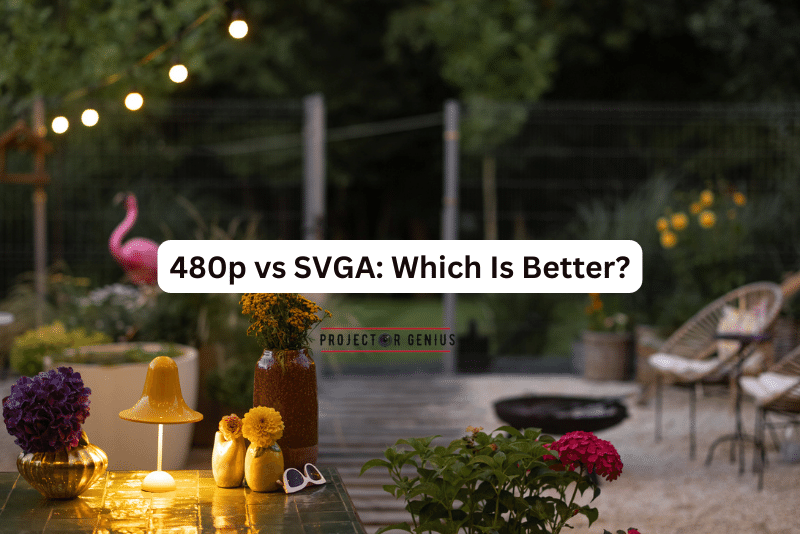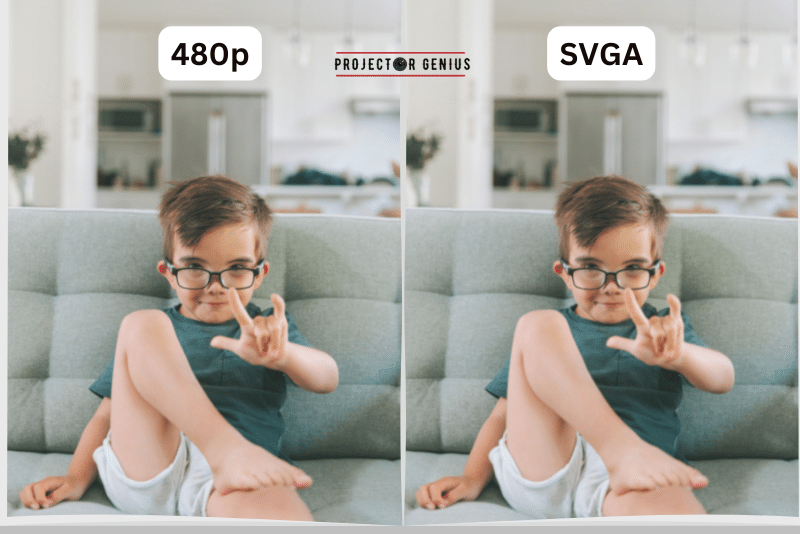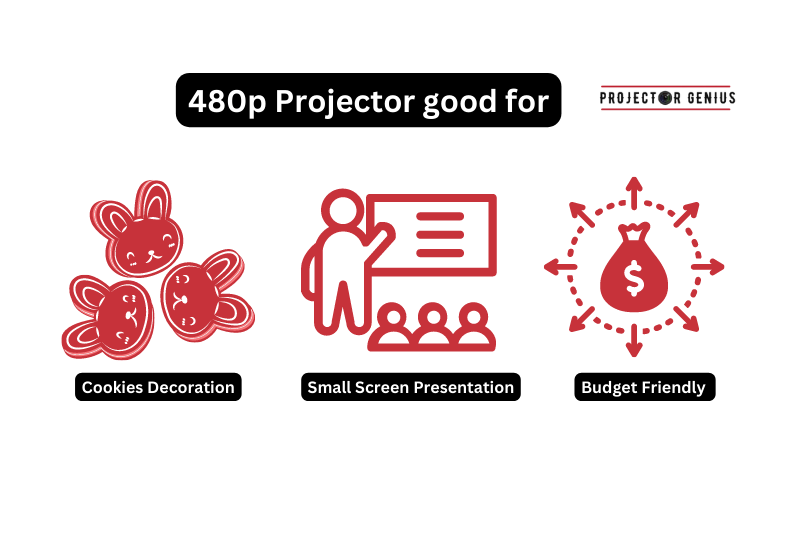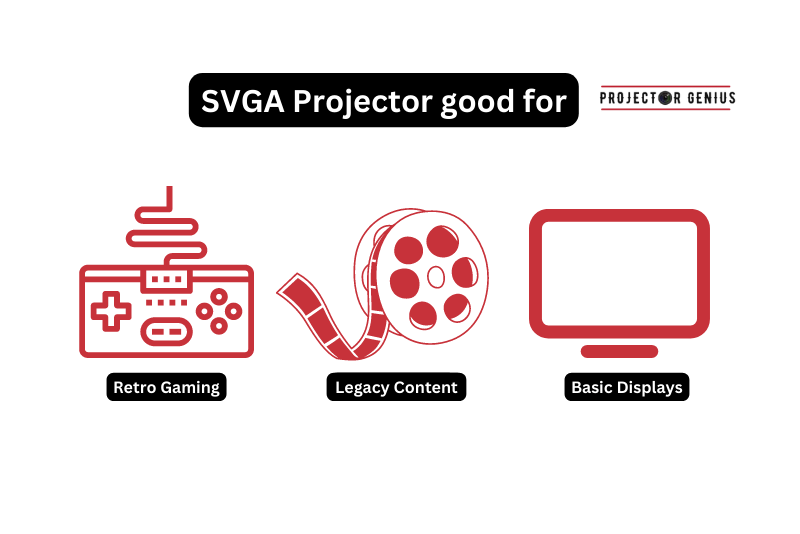480p vs SVGA: Which Should You Get In 2023?
-
 Written by:
Kristy Roger
Written by:
Kristy Roger
- Last Updated:

Are you wondering which is better: 480p vs SVGA? There are many different types of resolutions to choose from depending on your budget and needs. In this article, projector expert Kristy Roger shares her knowledge on 480p vs. SVGA comparison, with pictures of each and easy day-to-day life examples!
480p vs SVGA: Which Is Better? 480p and SVGA are both video resolutions, but they have different dimensions and quality. 480p has a resolution of 720×480 pixels, while SVGA stands for Super Video Graphics Array and typically refers to a resolution of 800×600 pixels. SVGA offers slightly higher quality and more pixels compared to 480p.
I recommend using the Table of Contents to quickly access the information you need.
My article is designed to cater to home cinema users of all levels, from Beginners to Advanced enthusiasts.
Table of Contents
480p vs SVGA: What’s the Difference?
The main difference between them is image quality and number of pixels.
Let’s talk about what to keep in mind when you’re trying to decide between 480p and SVGA. It’s like picking the right tool for the job – you want to make sure it fits your needs perfectly.
What is 480p?
When a video is in 480p, it means the image is made up of 480 horizontal lines that show all the action and details. The “p” stands for “progressive scan,” which is a way the video is displayed on your screen. It’s not the highest quality out there, but it’s still pretty good, especially if you’re watching on smaller screens like phones or older TVs.
In simple words, 480p is like the basic level of video quality, not as super clear as high-definition stuff, but it gets the job done and lets you watch videos without them looking all blurry or pixelated.
Feel free to read my comprehensive comparison of
What is SVGA?
SVGA stands for Super Video Graphics Array. It’s a display standard used for video output in personal computers and other devices. SVGA is an extension of the VGA (Video Graphics Array) standard, which was introduced in the late 1980s.
SVGA offers improved graphics resolution and colour depth compared to VGA. It supports a variety of resolutions and colour depths, typically ranging from 800×600 to 1600×1200 pixels and supports a wider range of colours. This increased resolution and colour depth made SVGA particularly well-suited for tasks that required more detailed graphics, such as graphic design, gaming, and multimedia applications.
It’s important to note that SVGA is an older standard and has largely been surpassed by more modern display technologies, such as High Definition (HD), Full High Definition (FHD), and even higher resolutions like 4K and 8K. However, SVGA was a significant step forward in the evolution of computer graphics and played an important role in shaping the development of display standards.
If you want to learn more, read my comprehensive comparison of WXGA vs XGA vs SVGA.
The Key Difference Between 480p and SVGA
480p
Resolution: 640×480 pixels.
Aspect Ratio: Typically 4:3, creating a more square-ish visual layout.
Image Clarity: Provides decent clarity for its era, suitable for older CRT TVs.
Contrast Ratio: Contrast ratio wasn’t a primary focus; it was more about content display.
Usage: Mainly used for standard-definition TV broadcasts, DVDs, and older video game consoles.
SVGA (Super Video Graphics Array)
Resolution: Offers variable resolutions like 800×600, 1024×768, etc., resulting in better image clarity.
Aspect Ratio: Often 4:3, but SVGA is more adaptable to different aspect ratios as needed.
Image Clarity: Significant improvement over 480p, delivering clearer graphics and text on computer screens.
Contrast Ratio: While not a central feature, SVGA aims for improved visuals on computer displays.
Usage: Exclusively used for personal computer graphics, enhancing visual quality on monitors.
In summary, 480p served video content on traditional TVs with decent but not remarkable clarity, while SVGA catered to computer displays, offering a range of resolutions and significantly improved image clarity for a better overall visual experience.
Does Resolution Impact the Quality of Images and Videos Equally?

Yes, Resolution does impact the quality of images and videos, but the impact might not be equal for both. Let’s break it down:
Images: Higher resolution directly correlates with image quality. More pixels mean finer details and sharper edges. So, when it comes to images, increasing the resolution can significantly enhance the quality, making them appear more lifelike and clear. It’s like having a high-definition photograph that lets you zoom in without losing clarity.
Videos: Video quality is influenced by both resolution and other factors like frame rate and compression. While higher resolution does improve the visual clarity, other elements like frame rate (how smoothly the video plays) and compression (how efficiently the video is stored) also play vital roles. So, while resolution matters, it’s not the sole factor that determines video quality.
Think of it this way: increasing resolution for images is like adding more dots to a painting for finer details, while for videos, it’s like making sure those dots move smoothly and are stored efficiently. Both aspects contribute to overall quality, but the impact of resolution might be more immediately noticeable in images.
What Factors to Consider When Choosing Between 480p and SVGA?
Let’s compare 480p and SVGA resolutions like picking the perfect paint for your masterpiece. Here’s what to consider:
Resolution Clarity
480p has 480 lines of pixels vertically, while SVGA has 600 lines. SVGA offers a bit more canvas space for your visuals. It’s like choosing between a small canvas and a slightly larger one – more room to bring out the details.
Content-Type
Think about what you’ll be displaying. If it’s basic videos, slideshows, or presentations, both resolutions work well. But if you’re dealing with more intricate visuals, like detailed images or graphics, SVGA’s extra pixels might give your content a boost. It’s like selecting the right brush for the right stroke.
Screen Size
Consider the size of your screen or projection area. SVGA’s additional pixels can make a difference, especially on larger screens. It’s like enlarging a painting – more pixels mean smoother edges and finer details.
Device Compatibility
Check if your devices support both resolutions. While modern devices usually handle both, it’s like making sure your paints work on different types of paper. Compatibility ensures your content looks its best.
Budget
SVGA projectors might be a bit pricier due to the increased resolution. Think of it like selecting premium paint – you’re investing a bit more for a potentially richer result.
Intended Use
Are you presenting in a business setting or watching movies at home? For business presentations, SVGA’s added clarity could impress. But for casual content consumption, 480p might be sufficient. It’s like tailoring your artistic approach to the occasion.
In the end, it’s like choosing between using more paint colours or a larger canvas. Both 480p and SVGA have their merits – 480p is like a versatile palette that works well for many situations, while SVGA is like a larger canvas that can make certain visuals shine. Assess your needs and pick the resolution that’ll turn your content into a work of art!
What is the Difference in Aspect Ratio in 480p vs SVGA?
Let’s first understand what is aspect ratio.
What is the Aspect Ratio?
Aspect ratio refers to the proportional relationship between the width and height of a visual display or image. It’s represented as a ratio, usually expressed in the form of “width: height.” Aspect ratio plays a fundamental role in determining the shape and dimensions of screens, images, and videos.
For example, if an image or screen has an aspect ratio of 16:9, it means that for every 16 units of width, there are 9 units of height. This results in a wide, rectangular shape that’s often associated with modern widescreen displays and high-definition TVs.
Different aspect ratios have been used over time for various purposes. The traditional television used a 4:3 aspect ratio, resulting in a more square-shaped screen. Movie theatres often use wider aspect ratios to create a cinematic experience. More recently, the 16:9 aspect ratio has become standard for many devices due to its compatibility with both television and computer content.
The aspect ratio is important because it determines how content is displayed. If content doesn’t match the aspect ratio of the display, it might result in black bars (letterboxing or pillarboxing) or stretching of the image, impacting the visual quality and intended viewing experience.
480p Aspect Ratio
The aspect ratio of 480p is typically 4:3. Imagine a rectangle that’s 4 units wide and 3 units high. It’s like a classic painting canvas – not too wide or too tall, offering a balanced composition.
SVGA Aspect Ratio
SVGA also has an aspect ratio of 4:3. So, it’s the same as 480p in this regard. It’s like using the same canvas shape for two different paintings – they’ll have the same width-to-height proportion.
In simpler terms, the aspect ratios of both 480p and SVGA are like sticking to the same frame for different artworks. Both provide a traditional, almost square-shaped canvas that’s been the standard for many years. So, whether you’re dealing with 480p or SVGA, your content will fit snugly within this classic frame.
Is SVGA Resolution Higher than 480p?
Yes, SVGA resolution is higher than 480p. SVGA stands for “Super Video Graphics Array,” and it has a resolution of 800 x 600 pixels, which means there are 800 pixels horizontally and 600 pixels vertically on the screen.
On the other hand, 480p has a resolution of 640 x 480 pixels, with 640 pixels horizontally and 480 pixels vertically.
In terms of pixel count, SVGA offers more pixels both horizontally and vertically compared to 480p, making it a higher resolution. It’s like having a larger canvas to showcase your content, which can result in improved image clarity and detail.
Can I Connect a Device with 480p Output to an SVGA Monitor?
Yes, you can generally connect a device with 480p output to an SVGA monitor. The key factor here is that the SVGA monitor has a higher resolution (800 x 600 pixels) than the 480p output (640 x 480 pixels).
When you connect a device with a lower resolution output (480p) to a monitor with a higher resolution (SVGA), the monitor will typically display the content in its native resolution (800 x 600 pixels). The content from the 480p device will likely appear smaller on the screen, surrounded by a black border.
Think of it like displaying a smaller picture within a larger picture frame. The content won’t fill the entire screen, but you should still be able to see and interact with it.
Keep in mind that the exact behavior might depend on the specific device and monitor you’re using. Some monitors and devices might offer options for scaling or adjusting the display to fit better, but in general, connecting a 480p device to an SVGA monitor should work, even though the content won’t take full advantage of the monitor’s resolution.
Which resolution is better for presentations: 480p or SVGA?
SVGA is better than 480p for presentation. Let’s compare 480p and SVGA for presentations:
480p: This resolution (640 x 480 pixels) is a standard definition format. It’s like a reliable old projector that’s been around for a while. While not the highest resolution available, it can work well for basic presentations, especially if you’re focusing on simple graphics, bullet points, and text. Think of it as clear enough for conveying information without too much frill.
SVGA: SVGA (800 x 600 pixels) offers slightly more screen real estate than 480p. It’s like having a slightly larger canvas for your content. This can be beneficial for presentations that include more detailed graphics, images, or charts. It can make visuals appear crisper and more legible, which is particularly useful if you’re showcasing data or visual-heavy content.
So, if your presentations lean more towards simplicity and text-heavy slides, 480p might do the job. However, if your presentations involve detailed visuals and you want to ensure everything looks sharp and clear, SVGA could provide that extra edge.
Ultimately, it’s like choosing the right tool for the job – consider the complexity of your content and the visual impact you want to achieve, and pick the resolution that aligns with your presentation goals.
Is SVGA Resolution Suitable for Modern Gaming, or is 480p Better?

When it comes to modern gaming, both SVGA and 480p might fall short of meeting the expectations of today’s gaming experiences. Let’s break it down:
SVGA Resolution: SVGA (800 x 600 pixels) is considered quite low by modern gaming standards. While it might work for some older or less demanding games, modern games often feature detailed graphics, textures, and fast-paced action that would likely not look their best at this resolution. It’s like trying to fit a high-definition picture into a smaller frame – you might miss out on a lot of the visual splendor.
480p Resolution: 480p (640 x 480 pixels) is also relatively low in today’s gaming landscape. Like SVGA, it might suffice for older games or certain indie titles with less demanding graphics. However, for modern, graphically-intensive games, 480p might lead to a lack of detail, blurry visuals, and a less immersive experience. It’s like watching a blockbuster movie on a tiny screen – you’re missing out on the grandeur.
For a truly satisfying modern gaming experience, higher resolutions like 720p, 1080p, or even 4K are more suitable. These resolutions offer the visual detail, sharpness, and immersive quality that modern games demand. It’s like stepping into the game world with all the visual bells and whistles turned on.
In summary, while both SVGA and 480p have their uses, they might not provide the optimal gaming experience for modern, high-end titles. To fully enjoy the visual richness and excitement of modern gaming, higher resolutions are recommended.
Are there Budget-Friendly Options for High-Resolution Projectors?
I’ve often wondered if there are any wallet-friendly choices for projectors with high resolutions. So, I did a bit of digging, and the answer is yes! There are definitely budget-friendly options out there that offer impressive high resolutions.
I looked into different brands and models, and I came across the HAPPRUN 1080p projector, which is quite budget-friendly, ranging from around $135 to $150.
What caught my attention is that it even includes a 100-inch screen – talk about value! This projector delivers good resolution without breaking the bank.
It also supports various connection options like smartphones, HDMI, USB, AV, Fire Stick, and even PS5. This makes it a versatile choice for different entertainment needs.
It’s reassuring to know that I don’t necessarily have to spend a fortune to experience high-resolution visuals. The HAPPRUN projector seems like a solid option for those looking for quality without a hefty price tag.
So, if you’re on the hunt for budget-friendly high-resolution projectors, this one could definitely be worth considering.
Final Thoughts on 480p vs SVGA
While 480p and SVGA might have their applications, the digital world keeps evolving, and higher resolutions offer more immersive and detailed experiences. It’s like the ever-expanding palette of a painter – new colors and tools enhance the creative process.
Author of this Post:

Kristy Roger
Home Cinema Consultant & Tech Enthusiast
Holding a background in Industrial and Electrical Technology from the University of Alberta, Kristy has spent 5+ years consulting on home theater products at a top electronics firm. As a certified Technical Professional with Lean Six Sigma credentials, Kristy expertise ranges from projector nuances to hands-on experience with leading models. Kristy have been sharing her knowledge online for two years, blending professional insights with personal experiences from her own home cinema setup. Off the screen, She is a dedicated mom to Jerry, Ryan, and our two pups, Cuddle and Paw.





